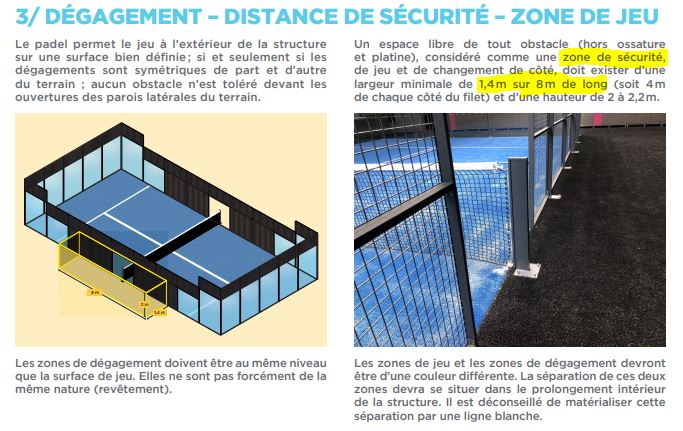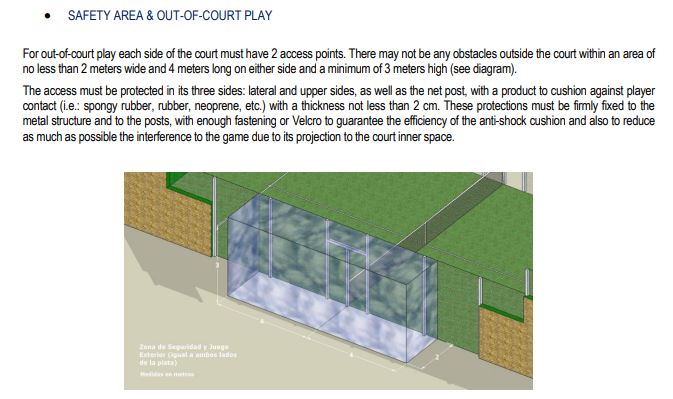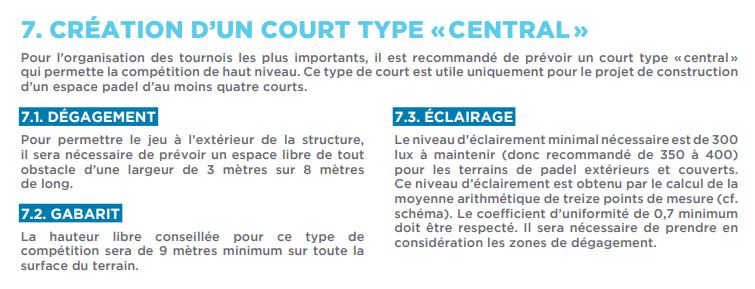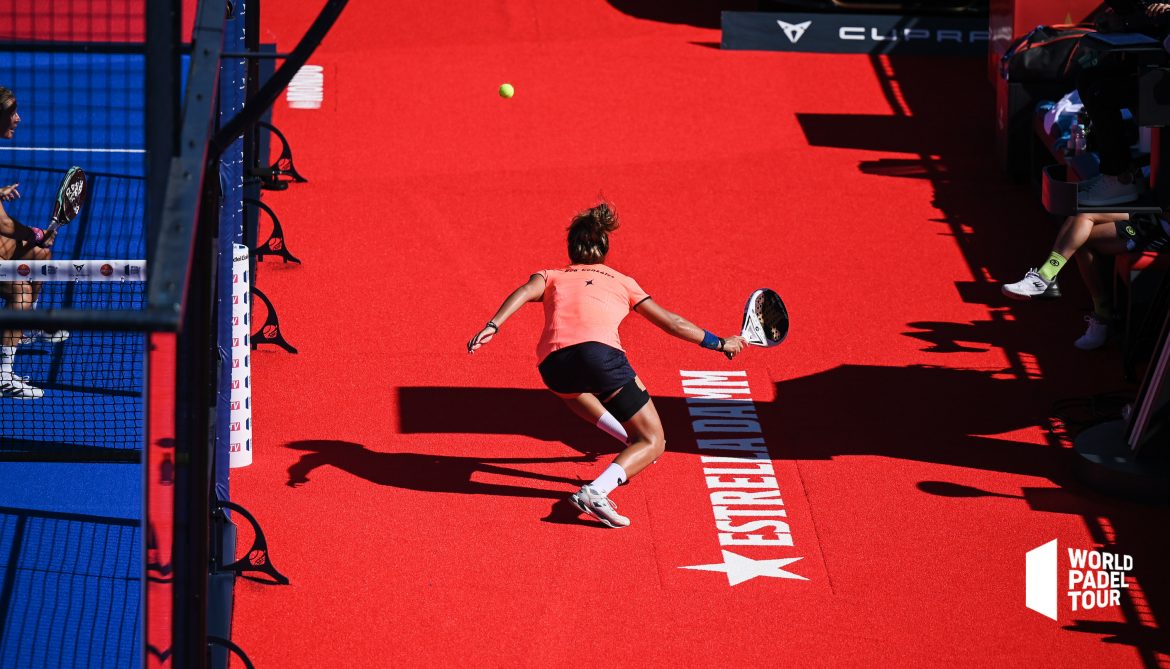When the level increases, players leave the field to defend “by 3”. But you still need to have the space to do it safely...
"All outings are final": you must have already read this sentence, written on tickets for concerts, amusement parks or fairs of all kinds. At padel, it's exactly the opposite: no exit (from the track) should be definitive – understand “fatal”.
It is precisely to prevent players from injuring themselves while going to retrieve a ball outside that standards govern the construction of fields. But what are these standards, exactly?
3 meters, 2 meters or 1,40 meters?
Some claim that you need a minimum of 3 meters, others say that you can settle for 2 meters, when it's not 1,40 m... Fortunately, the padel was not invented by the British, otherwise these distances would have to be calculated in feet or yards!
But let's try to see it more clearly.
Le FFT specifications indicates all the dimensions recommended for the construction of a padel. It is specified there (see photo below) that the game outside is only possible if the ground offers symmetrical clearing zones free of any obstacle. The recommended minimum size for these areas is 8 meters long, 1,40 m wide and at least 2 m high.

To allow outings, two fields located side by side must therefore be spaced at least 2,80 m apart. But is that enough to authorize exits during two matches played at the same time? Common sense says no: if two players go out at the same time (however unlikely that is), it absolutely cannot be done safely in such a small space.
Le specifications of the International Federation of padel – supposed to govern the game of professionals – is it the best say on this subject? The answer is yes ! As shown in the document below, the FIP recommends a larger clearance zone: the length is also 8 meters, but the width increases to 2 meters and the height to 3 meters. In volume, this safety zone is 2,14 times larger than that predicted by the FFT (and 1,43 times larger in area).

Are two adjoining grounds separated by 4 meters sure to guarantee sufficient security for the “acrobats” defending par 3s? We can debate the question, but for us, it's always "no": a player carried away by his momentum has very little chance of being able to stop his race inside the 2 meters...
Protect post and door frame
On the other hand, we give a good point to the FIP because it imposes to protect the post of the net and the frame of the door by rubber, plastic or neoprene, in order to reduce the risk of injury in the event of impact. The FFT also recommends protection, but only for the post and the net tensioning system.
But the French Federation does not admit defeat: it goes a little further than the FIP in at least one area. For clubs with at least four tracks and wishing to host high-level competitions, it recommends the construction of at least one center court. This must have a clearance (or safety zone) of at least 8 x 3 meters and, ideally, a ceiling height of 9 meters or more.

There you go, you know everything (or almost) about exit security. It is up to each club to find the best compromise between optimal security and the need to optimize space by accommodating as many tracks as possible in a number of square meters that is never unlimited.
After 40 years of tennis, Jérôme falls into the pot of padel in 2018. Since then, he thinks about it every morning while shaving… but never shaves pala in hand! Journalist in Alsace, he has no other ambition than to share his passion with you, whether you speak French, Italian, Spanish or English.





































































































 4 Fiberglass Padel Courts for The Ville de Paris: a choice that looks to the future
4 Fiberglass Padel Courts for The Ville de Paris: a choice that looks to the future Olympic Games: Club France will have its 4 tracks padel !
Olympic Games: Club France will have its 4 tracks padel ! Brussels Premier Padel Brussels P2 – Collombon / Bidahorria falls against Brea / Gonzalez
Brussels Premier Padel Brussels P2 – Collombon / Bidahorria falls against Brea / Gonzalez FIP Promotion Sharjah – De Meyer / Figuerola in the second round
FIP Promotion Sharjah – De Meyer / Figuerola in the second round Guillaume Codron de Sud Padel : “A family project”
Guillaume Codron de Sud Padel : “A family project” Nallé Grinda: “Democratize the padel in the USA with PadelX "
Nallé Grinda: “Democratize the padel in the USA with PadelX " Simon Boissé: “We know that there are two nations in front of us”
Simon Boissé: “We know that there are two nations in front of us” Marie Maligo: “This period of frequent changes of partners was beneficial for me”
Marie Maligo: “This period of frequent changes of partners was beneficial for me” Gilles Moretton: “We will be able to put the padel at the level of tennis”
Gilles Moretton: “We will be able to put the padel at the level of tennis” Two P1000 doubled prize money approaching!
Two P1000 doubled prize money approaching! José Manuel Escin at the inauguration of Casa Padel DOS: “Finally, and thank you!”
José Manuel Escin at the inauguration of Casa Padel DOS: “Finally, and thank you!” The 2024 European Junior Championships in Budapest in September!
The 2024 European Junior Championships in Budapest in September! Padel Score comes to Tahiti for American Express Padel Cup!
Padel Score comes to Tahiti for American Express Padel Cup! Do you know the Rafa Nadal Academy Tour?
Do you know the Rafa Nadal Academy Tour? Play at padel on his yacht? Possible for €233.000!
Play at padel on his yacht? Possible for €233.000! Our Top 10 training courses padel in France and Europe
Our Top 10 training courses padel in France and Europe At the heart of padel – Episode 25: Paul and Andoni answer your questions
At the heart of padel – Episode 25: Paul and Andoni answer your questions Tactical padel – What to do when faced with players who systematically stay at the bottom?
Tactical padel – What to do when faced with players who systematically stay at the bottom? The basic tactics of padel
The basic tactics of padel At the heart of padel – Episode 25: Paul and Andoni answer your questions
At the heart of padel – Episode 25: Paul and Andoni answer your questions At the heart of padel – Episode 23: defend the window well
At the heart of padel – Episode 23: defend the window well Prohibition on playing topless Padel : the reasons
Prohibition on playing topless Padel : the reasons FIP Tour – Going far from Europe, THE strategy to earn points!
FIP Tour – Going far from Europe, THE strategy to earn points! What is a good football player? padel ?
What is a good football player? padel ? “Lefties give me headaches when I play against them!”
“Lefties give me headaches when I play against them!” At the heart of padel – Episode 14: how to earn points in winter?
At the heart of padel – Episode 14: how to earn points in winter? A par 4 is always a winner...even if you manage to defend it!
A par 4 is always a winner...even if you manage to defend it! Carbon fiber VS fiberglass: what to choose?
Carbon fiber VS fiberglass: what to choose? How to effectively test a racket padel ?
How to effectively test a racket padel ? La padel to fight Parkinson's disease
La padel to fight Parkinson's disease Don't play with a cracked or broken racket, your body will thank you!
Don't play with a cracked or broken racket, your body will thank you! Michel Cymes: “The padel, physically, it’s serious!”
Michel Cymes: “The padel, physically, it’s serious!” Jeremy Gala: “Promote the padel among young people in Belgium remains a challenge”
Jeremy Gala: “Promote the padel among young people in Belgium remains a challenge” The French Touch Academy organizes its selection day Padel-Study
The French Touch Academy organizes its selection day Padel-Study Report on the detection and training of younger generations
Report on the detection and training of younger generations